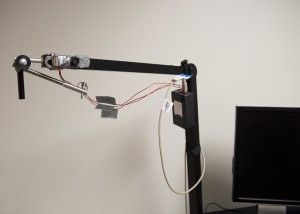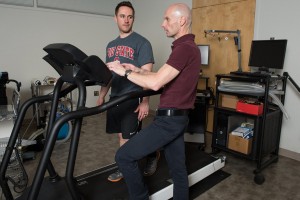Most people find running on treadmills to be incredibly boring. However, self-regulating treadmills can take the monotony out of typical indoor exercise. Treadmill technology has increased in the last decade to include features such as heart rate sensors, calorie counters, and even TVs. However, the runner has always been constrained to running at a constant uniform pace. The runner has to pick their speed and adjust to that. This is not compatible with the natural variation in pace that runners experience outside. Self regulating treadmills have already been researched, prototyped and tested however they have not been commercialized or patented yet. These treadmills are able to detect the speed of the runner on the treadmill in order to control the pace of the running belt below the runner’s feet. When the runner speed up, the belt’s speed will increase. The opposite is also true. When the runner slows down, the belt will decrease its speed.
This additional control is not vital to the function of the treadmill. However, the additive feature gives the runner the freedom to set the pace of his or her own workout instead of being controlled by the treadmill. It is often difficult for a runner to stay at the same pace the entire time he or she is running. This treadmill allows the runner to change speed quickly without having to push buttons or set a new pace on the monitor. Additionally, according to preliminary testing, this additional feature can improve the athletic performance of the runner. When tested on both regular and self regulating treadmill, experienced runners improved their VO2 max scores (a measure of the maximum volume of oxygen an athlete can use) by 4 to 7 percent. Controlling the position of the runner on the treadmill is also important for safety reasons. If the runner were to stumble or misstep, the belt would be able to slow down to allow the runner to safely recover. Also accidents which occur when people run into or fall off the treadmill would be reduced. Some treadmills like the one below have a safety clip to try to stop the treadmill if the runner falls too far behind. However, it doesn’t prevent the runner from running too far forward. A good range of operating conditions for this parameter would keep the runner within a foot from the center of the belt.

The treadmill works by adding a sonar range finder (shown below), a transmitter, a micro-controller and a computer. The sonar finder is placed at the back of the treadmill and is used to measure the distance between the runner and the sonar finder. Typically, the sonar is aimed between the shoulder blades of the runner since the position of a runner’s legs cycles while the position of a runner’s back is relatively consistent. The sonar finder measures the distance between the runner and the sonar device. It then sends this signal through the transmitter to the micro-controller. The process uses a feedback system, which makes changes to the system based on measurements in the output. As a consequence, this forms a reactive system. The micro-controller compares the runners current distance from the back of the treadmill to the distance between the back of the treadmill and the midpoint of the treadmill. If the measured distance is larger than the compared value, the belt speeds up to bring the runner back towards the middle. Conversely, if the measured distance is smaller, the belt slows down to allow the runner a chance to catch back up to the center.

The controlled variable is the distance between the runner and the back of the treadmill. In order to control the distance, the treadmill manipulates the speed of the belt via the mechanical work done by the rotators. The range of the sonar’s distance would be from the end of the treadmill to the front of the treadmill. Other readings should be at saturation because a person has to be on the treadmill. The controller would also limit the maximum possible speed as a safety precaution. If the person’s position changes the controller should not overshoot the maximum safety limit because it might cause the runner to fall. The minimum speed of the treadmill would be zero.

Potential disturbances to the system include dramatic changes in runner velocity. If a runner were to stumble, trip or fall, their speed would be drastically reduced. Also the sonar needs to be able to tell the difference between a runner’s foot and a different object. For example if a runners water bottle fell right in front of the sensor, we wouldn’t want it to slow down too quickly thinking that the runner is too close to the sensor. Sonar sensors are already capable of differentiating between humans and other objects. Sonars send out ultrasonic sound waves that are then reflected off of people and things and returned to the sensor. The time it takes for the waves to return is used to calculate the distance. However, the intensity can be used to determine if the wave is being reflected off of a human. Several factors affect the intensity of the reflection including size and texture. Humans return ultrasound waves within a relatively small range of intensities. Therefore, if an intensity falls within this range it is extremely likely to be from a human.
The sensor would use a feedback loop. It would be hard to determine variances in the runners input. It is a lot easier to determine differences in a runner’s speed. If a runner wanted to increase his or her speed, he or she would run harder. Therefore, the runner to move forward on the treadmill. This would cause the sensor to detect the changing distance from the runner to the sensor. The sensor would transmit a signal and it would be compared with the set point signal. The controller would then speed up the treadmill until the runner is back at the set point distance.
In order to mimic the natural fluidity of running outdoors, treadmills could soon become capable of matching the runner’s pace instead of operating at a constant speed. This additional feature would improve athletic performance of the runner while hopefully creating a more exciting workout.
Works Cited
Bonar, Tom. “MaxBotix Inc., High Performance Ultrasonic Rangefinders.” Kiosk Sensor and People Detection. N.p., 07 Oct. 2012. Web. 31 Mar. 2016.
Grabmeir, Jeff. “New Design Makes Treadmill More like Running Outdoors.” News Room. N.p., 14 Apr. 2015. Web. 31 Mar. 2016.
Vergara, William C. “Science Explorations: Journey Into Space: Radar and Sonar | Scholastic.com.” Science Explorations: Journey Into Space: Radar and Sonar | Scholastic.com. N.p., n.d. Web. 31 Mar. 2016.